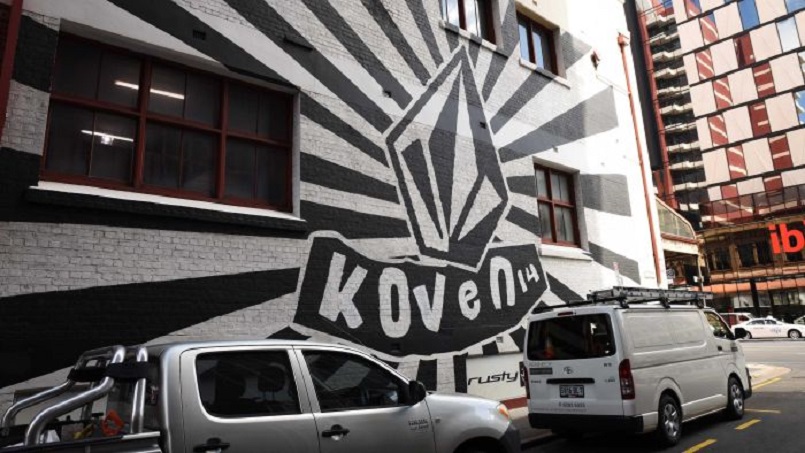
A nanny state, a regimented culture, gratuitous rules that defy common sense, they are all driving forces behind rebellious vandalism, according to one of Adelaide's most notorious graffiti artists.
The illusive artist who goes by the name Koven has been writing his tag on structures and walls around the city since the mid 2000s.
He is perhaps one of the city's most recognised writers due to some audacious roll-ups (graffiti painted up high on buildings, often with rollers).
In more recent years, however, his tag has appeared in small stickers placed on street lights, stobie polls, poster walls and pubs.
"I haven't done a big roll-up since 2013, which is how I like getting up," Koven said, after agreeing to speak to the ABC anonymously.
"You get more recognition for doing something like that than for 50 little pieces. They're good for a small fringe culture, but I want to appeal to a bigger audience."
Koven is in his 30s and started tagging after spending time in Melbourne, where he became influenced by people he met.
He said the rebellious side attracted him, "the criminal side, although nothing crazy".
"I've always been attracted to the fringe and other subcultures," Koven said.
"Growing up in Australia, everything's so regimented, the laws, the nanny state, such as, and I know it's changed now, not being allowed to stand up and drink outside bars.
"Here, a sports star gets into trouble and no-one gives a shit, but if you do something else."
Tagging is a language you 'have to learn'
Koven does not consider himself a street artist and acknowledged there were "far more talented people" on the streets than himself.
He found himself drawn to tagging, graffiti, or what some would call vandalism, explaining it as a way to "associate with your city".
He said tagging was a language a person had to learn, and one that revealed a lot about a street identity.
"There's a rawness to it," Koven said.
"I can look at a tag and see how they stood [while writing], or if somebody has only just started, because the more you do it, the better you get.
"Tagging is vilified because it's obviously criminal damage, but that's part of the appeal to the younger side."
He said the style of a writer was often based on a situation.
"Roadside spots, you need to be quicker, but somewhere more relaxed, you can do something more fancy," Koven said.
The city of Adelaide has made steps towards embracing street art in recent years, with sanctioned — albeit safe and sometimes unimaginative pieces — appearing in a variety of well-exposed walls.
Many artists, however, are still defying the law to paint without approval.
"It's always been risky," Koven said.
"The laws are only going to get worse, even though public opinion is changing with street art."
A pastime that's 'pretty high-risk'
Koven recounted an occasion where he and three others were doing a piece in an empty lot adjacent a main road when a police car pulled up.
"We all hit the deck, but the cop was pulling somebody over on the road," Koven said.
"We only hoped they couldn't smell the fresh paint from a half-done piece, but for 10 minutes we could see the lights flashing. It was lucky we were in overgrown grass."
Koven has been chased by citizens, and said he has also broken his leg after jumping a fence.
"I always plan out what I'm doing when I do the bigger stuff," he said.
"At the end of the day, it's pretty high-risk, 'cause it can f... up your life if you get caught."
He explained that he would choose a street or area, and spend two hours to systematically distribute his name.
"Anything council is fine. Public property is preferred, but you want to do what stays up and council property is pretty often buffed."
Many of Koven's large-scale roll-ups have been accompanied by other names.
"I don't like painting alone, especially the big stuff," Koven said.
"It's good to have a look out and I feel safer if I've got someone to look out.
"Some I've known before, others I've met through graffiti, but I try not to get too involved with graffiti people and the scene. The less people you know in that subculture, the better."
